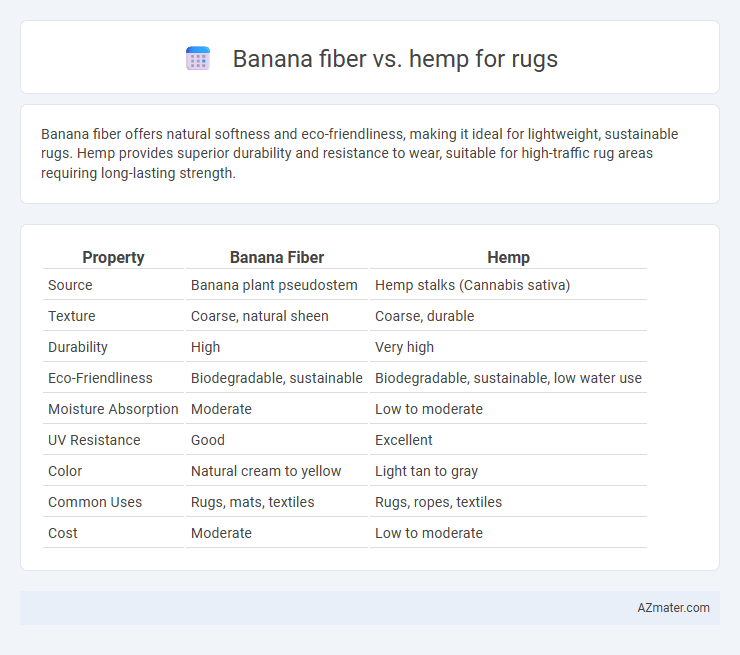Banana fiber offers natural softness and eco-friendliness, making it ideal for lightweight, sustainable rugs. Hemp provides superior durability and resistance to wear, suitable for high-traffic rug areas requiring long-lasting strength.
Table of Comparison
| Property | Banana Fiber | Hemp |
|---|---|---|
| Source | Banana plant pseudostem | Hemp stalks (Cannabis sativa) |
| Texture | Coarse, natural sheen | Coarse, durable |
| Durability | High | Very high |
| Eco-Friendliness | Biodegradable, sustainable | Biodegradable, sustainable, low water use |
| Moisture Absorption | Moderate | Low to moderate |
| UV Resistance | Good | Excellent |
| Color | Natural cream to yellow | Light tan to gray |
| Common Uses | Rugs, mats, textiles | Rugs, ropes, textiles |
| Cost | Moderate | Low to moderate |
Introduction to Banana Fiber and Hemp
Banana fiber, extracted from the pseudostem of the banana plant, offers a sustainable, biodegradable option with a natural sheen and strong tensile strength, ideal for eco-friendly rugs. Hemp fiber, derived from the stalk of the Cannabis sativa plant, is renowned for its durability, resistance to mold and UV rays, and coarse texture, making it suitable for high-traffic rug areas. Both fibers provide environmentally responsible alternatives to synthetic materials, with banana fiber delivering a softer feel and hemp excelling in toughness and longevity.
Botanical Sources and Cultivation
Banana fiber, derived from the pseudostem of the Musa plant, thrives in tropical regions with high humidity and requires minimal chemical inputs, making it an eco-friendly option for rug production. Hemp fiber comes from the stalk of the Cannabis sativa plant, known for its rapid growth cycle and ability to sequester carbon, cultivated widely in temperate climates with low water needs. Both fibers offer sustainable cultivation benefits, but banana fiber is more suited to tropical environments, while hemp is adaptable to diverse soils and climates.
Environmental Impact and Sustainability
Banana fiber, derived from the pseudostem of banana plants, is a biodegradable and renewable resource that requires minimal water and pesticides, making it a highly sustainable choice for rugs. Hemp fibers, known for their durability and fast growth with low environmental footprint, absorb substantial amounts of CO2 during cultivation, contributing positively to carbon sequestration efforts. Both fibers offer eco-friendly alternatives to synthetic materials, but hemp's higher yield and robustness often result in a lower overall environmental impact per square meter of rug produced.
Fiber Extraction Processes
Banana fiber extraction involves retting and scraping the pseudostem to separate long, coarse fibers ideal for creating durable rugs with natural sheen. Hemp fiber extraction typically uses decortication, where the stalk is mechanically broken and fibers are separated for coarse, strong material known for high abrasion resistance in rug making. Both fibers undergo processes aimed at maximizing tensile strength and flexibility, but banana fiber extraction is more labor-intensive, impacting texture and sustainability profiles for rug applications.
Physical Properties and Durability
Banana fiber boasts excellent tensile strength and natural flexibility, making it resistant to wear and ideal for rugs requiring durability and softness. Hemp fibers exhibit superior abrasion resistance, high tensile strength, and moisture-wicking properties, ensuring rugs retain their structural integrity over time even in high-traffic areas. Both fibers offer eco-friendly benefits, but hemp's significantly higher durability and resistance to mildew make it a preferred choice for long-lasting rug applications.
Texture, Appearance, and Aesthetics
Banana fiber rugs feature a coarse, fibrous texture with a natural sheen that enhances rustic and organic aesthetics, making them ideal for eco-friendly interiors. Hemp rugs offer a smoother, denser weave with a matte finish, providing a more refined and durable surface suited for versatile decor styles. Both fibers are sustainable, but banana fiber's unique uneven texture creates a distinctive artisanal look, whereas hemp's consistent texture lends itself to clean, contemporary designs.
Dyeing and Color Retention
Banana fiber exhibits excellent dye absorption, resulting in vibrant hues that remain stable over time, making it suitable for rugs requiring rich color intensity. Hemp fibers also dye well but tend to have a more muted, natural color palette with strong resistance to fading, especially under sunlight exposure. Both fibers offer durable color retention, though banana fiber's smooth texture enhances dye uniformity, whereas hemp's coarser surface provides a rustic, earthy aesthetic.
Cost and Market Availability
Banana fiber rugs typically cost less than hemp rugs due to lower processing expenses and abundant banana plant waste in tropical regions, making them more accessible for budget-conscious consumers. Hemp rugs, although pricier because of higher cultivation and extraction costs, offer superior durability and a growing market demand in eco-friendly home decor. Market availability of banana fiber rugs is concentrated in South and Southeast Asia, while hemp rugs have broader distribution channels across North America and Europe driven by increasing sustainability trends.
Maintenance and Longevity of Rugs
Banana fiber rugs require gentle cleaning with mild soap and water, as their natural fibers can degrade with harsh chemicals, while hemp rugs are highly durable and resistant to stains, allowing for easier maintenance with regular vacuuming and occasional spot cleaning. Hemp fibers offer superior longevity due to their strong, mold-resistant properties, often lasting decades even in high-traffic areas, whereas banana fiber rugs may show wear more quickly and need replacement sooner under similar conditions. Choosing hemp for rugs ensures lower maintenance efforts and extended durability, making it ideal for both residential and commercial settings.
Conclusion: Which Fiber is Best for Rugs?
Hemp fiber offers superior durability and natural resistance to mold and pests, making it an excellent choice for long-lasting rugs. Banana fiber is softer and environmentally sustainable, but it tends to be less durable under heavy foot traffic. For rugs requiring high strength and longevity, hemp fiber is generally the best option.

Infographic: Banana fiber vs Hemp for Rug
 azmater.com
azmater.com